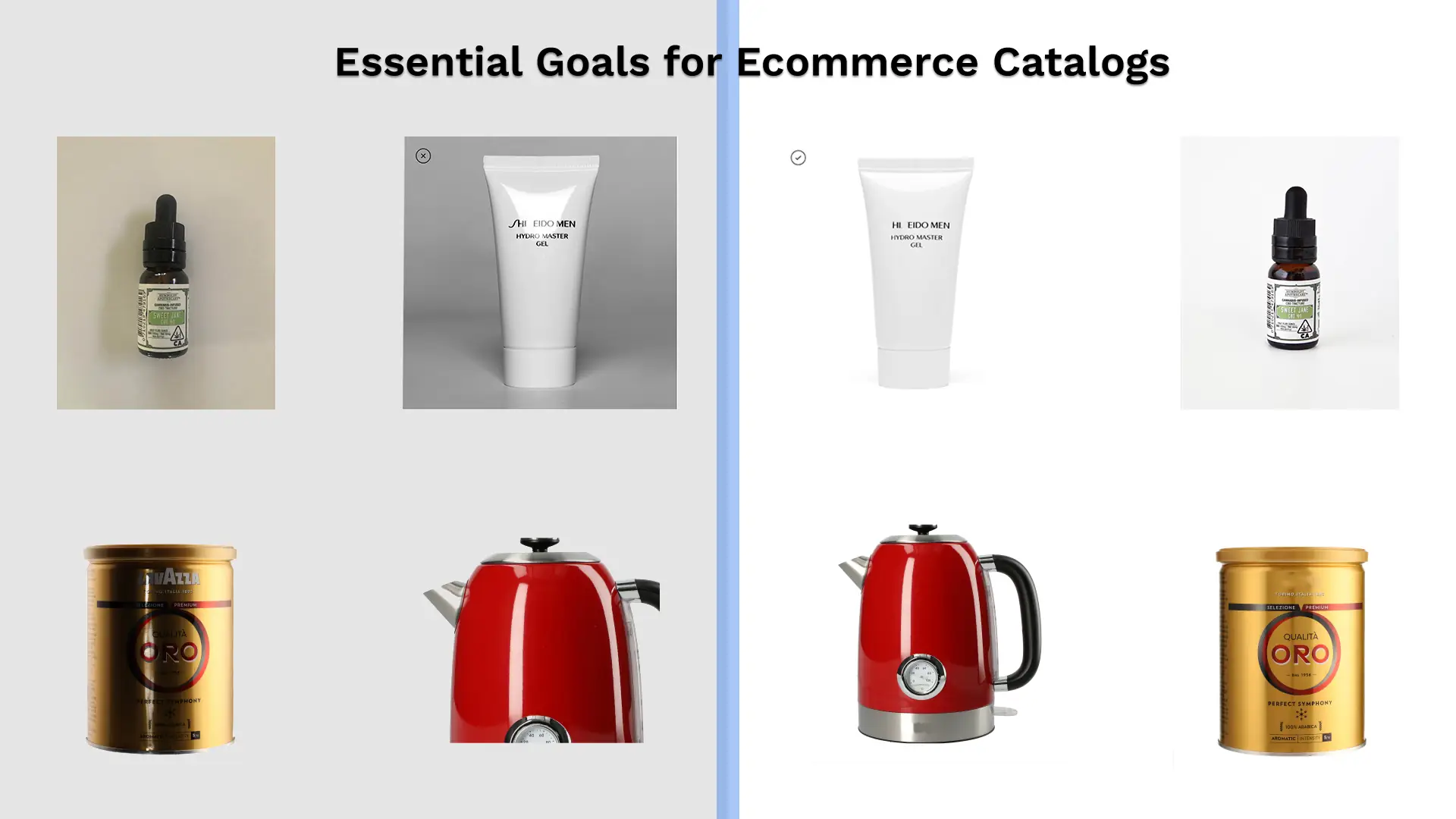It’s no secret that people nowadays prefer to buy almost everything online. In 2018, as per Internet Retailer’s analysis, online business accounted for over 50% of global web sales. It means more companies are bringing their assets online, and more people are purchasing from these marketplaces. So, whether you are selling online or offline, your business needs attractive ecommerce catalogs to showcase your products and services.
It is one of the efficient ways to grab the viewer’s eye and increase sales chances. One of the most significant ingredients for your ecommerce product catalog is the professional product images that help you attract the viewer’s attention.
Businesses are now inclined towards creating elegant, personalized, and intuitively designed digital product catalogs to help users to search more precisely and effectively. This is primarily fueled by the massive growth in online traffic on eCommerce websites and online marketplaces, the majority being mobile traffic.
An electronic catalog in ecommerce is one of the principal components of any business that reinforces brand and product awareness. It consolidates a database of information on all the available products to be sold or launched. It helps you inform and educate your audience about the product and services and grab the viewer’s attention towards the product.
While studying modern consumer behavior, Big Commerce revealed that 82 percent of cell phone users research purchases online before buying the product, even when they anticipate buying it from a store.
As per Accenture, 72 percent of B2B organizations prefer to conduct product research online before buying the products. It determines how necessary e-commerce merchandising has become for businesses if you want to foster, sell your product, or bring it online decisively.
What is an Ecommerce Catalog?
An eCommerce catalog is an online database that showcases all the products an eCommerce business offers in an organized and appealing manner. It includes product descriptions, images, pricing, etc., which help customers make informed decisions. An eCommerce catalog can be accessed through a website or mobile application. It typically includes a search function and filters to help customers find products that meet their needs. It has features such as product reviews and ratings and related product suggestions.
A well-designed and user-friendly eCommerce product catalog is essential for any online business, as it can help attract and retain customers and increase revenue. Managing digital eCommerce catalogs is a continuous process that involves organizing products in a specific manner to maintain uniformity and quality data across sales channels. An online catalog is a repository of product information that includes the product name, description, price, supplier, and other relevant details.
This helps businesses reach a wider audience, reduce operational expenses, and provide consumers the convenience of shopping from home. Additionally, consumers can compare products and prices across different brands. The key objective of eCommerce catalog management is to maintain consistency in product data and messaging across all sales channels. As a crucial customer-centric sales strategy, effective catalog management for eCommerce can significantly impact the success of online businesses.
Essential Goals for Ecommerce Catalogs
Most of your business depends on how and where you sell your products or services. Here is how you can achieve the goal of higher sales through cataloging.

So, some tips for your e-commerce cataloging services are as follows.
1. Starting with an Online Presence
Starting and increasing online presence is essential for any business to reach a wider audience and boost sales. Here are some steps to increase online presence:
- Build a user-friendly website: Create a website that is easy to navigate, visually appealing, and optimized for search engines.
- Optimize for search engines: Use relevant keywords throughout your website content, meta descriptions, and tags. This can help improve your website’s ranking on search engine results pages.
- Create high-quality content: Produce high-quality content relevant to your target audience. This can include blog posts, videos, PowerPoint slides, infographics, and more.
- Use social media: Build a strong presence on social media platforms like Facebook, Twitter, LinkedIn, and Instagram. Share engaging content and interact with your followers.
- Invest in paid advertising: Consider using paid advertising on search engines, social media, and other relevant platforms to reach a wider audience.
- Build backlinks: Build high-quality backlinks from other reputable websites to your website. This can improve your website’s ranking on search engines and increase your online visibility.
- Monitor website traffic: Use website analytics tools to monitor website traffic, user behavior, and other vital metrics. This can help you make data-driven decisions to improve your online presence.
2. Do not sell everything, anywhere
While you launch available products, you must ensure that you sell them at the desired marketplace that suits your business. Since you need to pay a commission to sell your products online, you must showcase the best products you are sure about. This will create a great impression on potential customers and limit irrelevant content that might tarnish your brand’s image.
3. Categorizing your Products
One of the best ways to increase your sales while dealing with ecommerce cataloging is categorizing the related items in one place. And providing alternative insights to the customers while searching for a product.
For example, many sellers on Amazon try to show you related items when you search for any product. Say, you are looking for a wrist watch. Relevant items will appear as you open the product to read the specifications (different watches – similar to the one you are looking for), allowing you to choose the most relevant.
Even Amazon has picked up this seemingly effective strategy to show related products that are usually brought together. For example, suppose someone searches for a badminton racquet on your marketplace/eCommerce website. In that case, it will show them a pack of shuttlecocks alongside the racquet in the ‘Frequently brought together’ section, which makes buyers realize the requirement of shuttlecocks when they buy the racquet, helping you sell another product.
4. Automate your Ecommerce Catalog Management
Getting online exclusively means saving time, having a robust online presence, and vigorous brand awareness. To expand your product base, make sure you automate your marketplace strategically.
There are plenty of tools and solutions to help you manage your ecommerce online catalog and enable you to steer your inventory. Ecommerce product catalog management through such software and tools becomes exponentially more convenient.
Ecommerce catalog software such as Sellbrite, ChannelAdvisor, Pattern, CedCommerce, and GeekSeller allows you to work with multiple shopping carts and popular marketplaces like Amazon, Shopify, eBay, Alibaba, etc. It lets you easily synchronize the database and manage inventory across the sales channels. It saves your time to micromanage your products and allows you to have centralized control over inventory.
These software tools will allow you to:
- Manage multi-channel listings
- Focus on direct sales
- Automate repricing
- Improve online presence
Tip: While deciding on product pricing, offer freebies on product delivery. The visitor will likely purchase the product. According to a study by PayPal and ComScore, 72 percent of users will not buy the product if the shipping prices are high.
5. Make it User Friendly
The quality of your catalog determines the visibility of your products. So, make sure the pages of your ecommerce catalogs and directories are user-friendly and engaging. We recommend you have the following features in your digital product catalogs:
- The user-friendly layout of your pages
- A relevant and attractive title
- Appealing 360-degree professional images
- Product Category
- Relevant Keywords
6. Using Specific Keywords
How do you get your product on the first page of every related web search?
Keeping yourself updated with the latest Marketing Trends, using specific keywords, and optimizing your content in an easily indexable way can help you reach out to the right audience.
Say you are selling camping gear. You want to reach out to the users searching for things like tents, backpacks, airbeds, and other items in your stock. To achieve this, you must optimize your website and use specific keywords to attract buyers.
Now the point is that you are not just offering these products. You need to sell them. Therefore, using keywords like ‘tents, airbeds, backpacks’ won’t do your job. To get more traffic, you must use specific phrases or keywords to lure the customer. That’s where SEO – Search Engine Optimization – comes in. Your products should appear not just in the marketplace search, but also in Google (other search engines) search result pages. This will ensure maximum traffic flow to your product pages, increasing your sales potential.
According to Moz, Longtail Keywords constitute over 70 percent of online searches. Using phrases like ‘all-weather tent for 4 people,’ ‘2 Person Camping & Hiking Tent, Under Rs X, tend‘, etc., in product descriptions can help you achieve your goal of being easily searchable.
7. Use Professional Product Images
Professional product images are essential for several reasons:
- Attracting attention: Professional photos can help your products stand out in a crowded online marketplace, drawing more attention from potential customers.
- Building trust: High-quality product images can help build trust with your customers by showcasing your products in the best possible light.
- Providing information: Professional images can help customers understand the features and benefits of your products more clearly, providing the information they need to make informed purchasing decisions.
- Increasing sales: Studies have shown that high-quality product images can increase conversion rates and sales, as customers are more likely to buy when they can see and understand the product clearly.
- Branding: Professional images can help reinforce your brand identity and message, creating a consistent and recognizable image for your business.
Additional Tips for Ecommerce Catalogs
Here are some additional tips that you should keep in mind when creating digital catalogs for your online retail business:

- Keep the layout simple and elegant – Use uniform font, style, size, and color.
- Page and product alignment – You should sort your products as per their quality. Place your best-selling products on your catalog page’s right or left side.
- Cross-selling – Cross-sell your products by placing similar products together.
- Cross-channel marketing – Use multiple channels to reach out to your potential buyers, say through an email, to increase your engagement and brand awareness by 166%.
- FAQs – Answer some Q&As that the consumers frequently ask about the product. It helps them to make an informed purchase.
- Pictures are everything – With product description in your catalog, provide multiple HD images with a uniform background to attract the eyeballs of the viewer that drive him to click the “Buy Now” button.
Automate the Cataloging with Spyne
Spyne offers Ecommerce photography services to help businesses create high-quality product images that are visually appealing and engaging. Spyne’s artificial intelligence uses its expertise and training in millions of images to automate the editing process of product images that showcase your products in the best possible light.
Many eCommerce photography services are offered, including product photography, 360-degree product photography, lifestyle photography, and more. Spyne’s API also provides image editing services to ensure your product images are flawless, consistent, and optimized for eCommerce platforms. Some more benefits for your image editing at Spyne includes:
- Taking care of lighting and angles
- Removing watermarks
- Color Correction
- Aligning the product centrally
- Background replacement
- Adding margins
And much more. If you also run an ecommerce website, then you too can avail many benefits, such as:
- Decreased time to market
- Increased cost-effectiveness
- Moderation/Validation of images
- Checks images for any vulgar content
- Giving images proper sizes for cataloging
And more! With Spyne’s Ecommerce photography services, you can enhance your online store’s visual appeal, improve customer engagement, and ultimately increase sales. Contact us today and help us grow your eCommerce business.
Conclusion
In conclusion, creating effective digital eCommerce catalogs is crucial for any online business that wants to thrive in this digital world. By following the tips and practices mentioned in this blog, you can create a visually appealing and user-friendly online catalog that showcases your products and drives sales.
Remember to focus on high-quality product photography, accurate and detailed product descriptions, and a seamless user experience. Ensure your catalog is easy to navigate, includes helpful filters and search functionality, and provides relevant product information.
Investing time and resources into creating a top-notch eCommerce catalog can improve your customers’ shopping experience, increase engagement, and ultimately grow your business. So don’t hesitate to take the necessary steps to optimize your online catalog and stay ahead of the competition. Also, you can choose to outsource the cataloging process to Spyne. This will provide you with the images that will be perfect for cataloging.




























